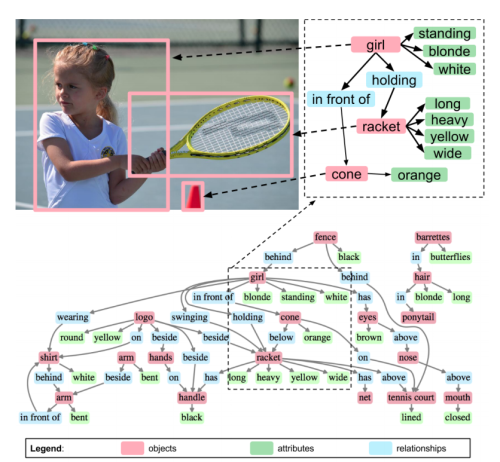What are AI and Machine Learning?
Artificial Intelligence and Machine Learning

“Scene Graph Example”, Justin Johnson, CC BY-SA 4.0
Artificial intelligence (AI) is the study and development of programs capable of problem solving. In the past decade, AI has gone from being mostly something you’d see in video games or in very specific engineering applications to embedded into our lives in both visible and invisible ways. For example, AI is behind everything from movie and product recommendations, to automatic grammar suggestions, self-driving vehicles, and robots that learn to walk. Many of these modern applications are a part of machine learning.
Machine learning (ML) is the branch of AI that studies how to create computer programs that adapt to data they’re given. The learning in this case is being given thousands, millions, or sometimes even billions of examples in order for the program to properly adjust its behavior to an acceptable degree of accuracy. Machine learning has been the source of most of the advances in artificial intelligence in the past decade.
“AI uses trial and error to invent rules that will help it reach its goal.”
– Janelle Shane, You Look Like a Thing And I Love You
It is important to understand that though these programs are often very powerful, inspired by human capabilities, and can behave in ways suggestive of human intelligence, they are ultimately limited pattern recognition and representation tools, trained by humans on curated data sets. All current AI technology is an example of Artificial Narrow Intelligence (ANI), which is the application of Machine Learning to specific problems. The concept of an Artificial Intelligence that can understand and reason in an unbounded system, in a manner similar to a human or animal, is known as Artificial General Intelligence (AGI). Current research and development towards AGI is extremely limited and the topic is still largely the province of Science Fiction and Philosophy.
The Generative AI Breakthrough
In late 2022, we hit a phase transition in how machine learning could be used to create text and transform text and images. These uses of AI to actually create artifacts rather than traditional uses like computer vision or predicting trends have been dubbed “generative” AI.
The first breakthrough was the release of stable-diffusion, an image generation program built off of a dataset with billions of images with English-language captions. Stable-diffusion allows us to create and edit images just by describing, in plain language, what the final image should look like.
Unlike prior generative image models such as Dall-e, Dall-e 2, and Midjourney stable-diffusion is small, efficient, and can be made to run on almost any modern computer with a dedicated graphics card. This opened up a new conversation about the role of generative AI and the ethics of building an art generator from existing artworks, one that is already having an impact on the humanities.
The second breakthrough was the release of OpenAI’s chatGPT, which was the first large language model (LLM) accessible to the masses. ChatGPT has already had an impact on jobs and education and we are still in the early phases of adoption. To read more about LLMs and education check the newsletters archived on this site!
The final breakthrough is the Llama-revolution, where alternatives to chatGPT – most of which are based on a model called LLama, developed by Facebook – are being made freely available and are tuned to run on devices as small as your smartphone. None of these models are as good at generating essays, transforming text, or building software as chatGPT but that’s only going to be a matter of time.
